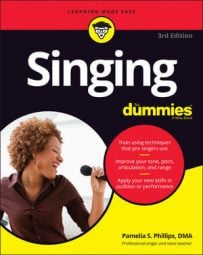When you sing, you need to know how to breathe properly as you sing the phrases of a song. As you sing, you inhale quickly and exhale slowly to gain the breath control you need to sing efficiently. Controlled breathing doesn’t come naturally, so train your body to breathe for singing.
The easiest way to find out how to breathe for singing is simply to feel it. Being able to visualize and feel the proper way to breathe makes the process more natural for you, too.
Inhalation refers to air moving into your body — breathing in. Exhalation is blowing out the air. You exhale when you speak or sing.
Inhaling to sing
Singing songs requires getting a full breath quickly — a quick inhalation — because the orchestra can’t wait five minutes for you to find the air. Knowing how your body feels when you inhale helps you quickly get air in your body so you can sing the next phrase. Use the following exercise to explore your own inhalation and get a feel for how your body needs to move when you inhale and exhale.
Pretend that you see someone you’re really happy to see. The surprise breath that you take feels like the air just rushed into your body. You can also pretend that someone told you something shocking.
You probably just took a really quick breath. Quickly filling your lungs with air is the way you have to breathe when singing.
When you’re working on breath control, you may find yourself yawning. The body gets confused with the different amount of air coming in, and you yawn. Most students yawn plenty during lessons and are embarrassed at first. They have to tell them that it’s okay to yawn when working on breath.
Exhaling to sing
Singing requires you to control your exhalation. You want to have a sustained and smooth exhalation so you can sing those demanding high notes and long, slow phrases.
To explore exhalation, try this exercise: Take a breath and say “Shhhh,” as if you’re trying to quiet some noisy children. Take another breath, and this time sustain the “Shhhh” as long as you can. While saying the “Shhhh,” notice what moves in your body as you exhale. You may feel that your abdomen or ribs are moving. At the end of the “Shhhh” (exhalation), you should feel the need to immediately inhale again.
Breathing can be confusing for a singer who’s just starting out, because you have to pay attention to so many things at one time. Different people who know something about singing also may tell you about yet another breathing method to use for singing.
One friend may say that his teacher wants him to leave his muscles out — sides, ribs, back — and distended as he sings or exhales; another friend may tell you that the abdominal muscles must move in when you exhale. Who do you believe? Both of them.
More than one method of breathing is useful, so you need to explore what works for you and understand why. You’ll likely encounter someone who claims to know all the answers about breathing, and you need to be familiar with your own breathing to understand your options.
Being an “innie” or an “outie” doesn’t refer to just your belly button — it also refers to how you breathe. Both methods are valid; you just need to understand how breath works in your body. Here’s more info about each:
-
The innie method focuses on moving the ribs and abdomen in gradually during exhalation. If you’re exploring breathing for the first time, start with these exercises.
-
The outie method requires the singer to focus on keeping the ribs or abdomen out during exhalation.

